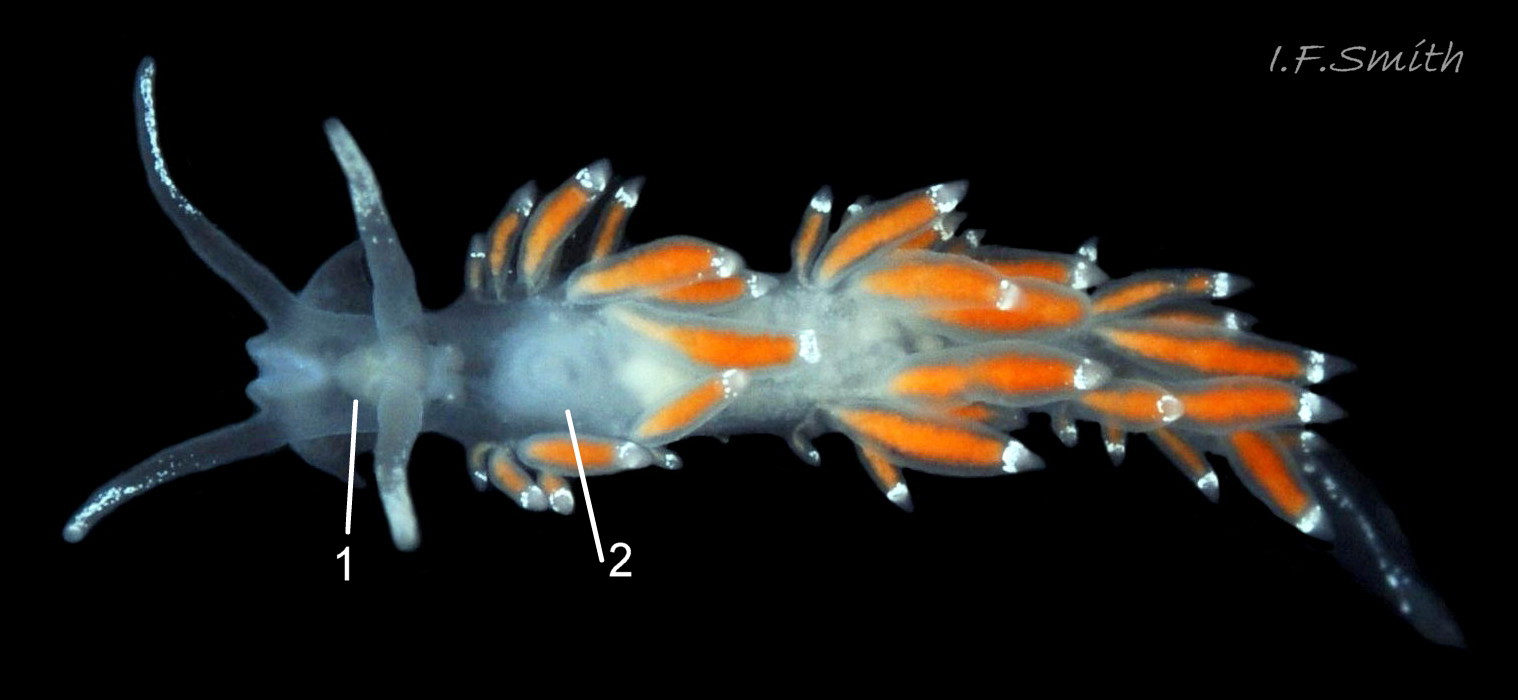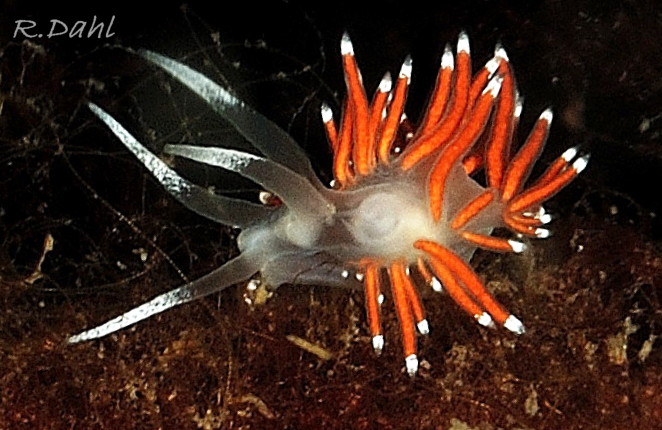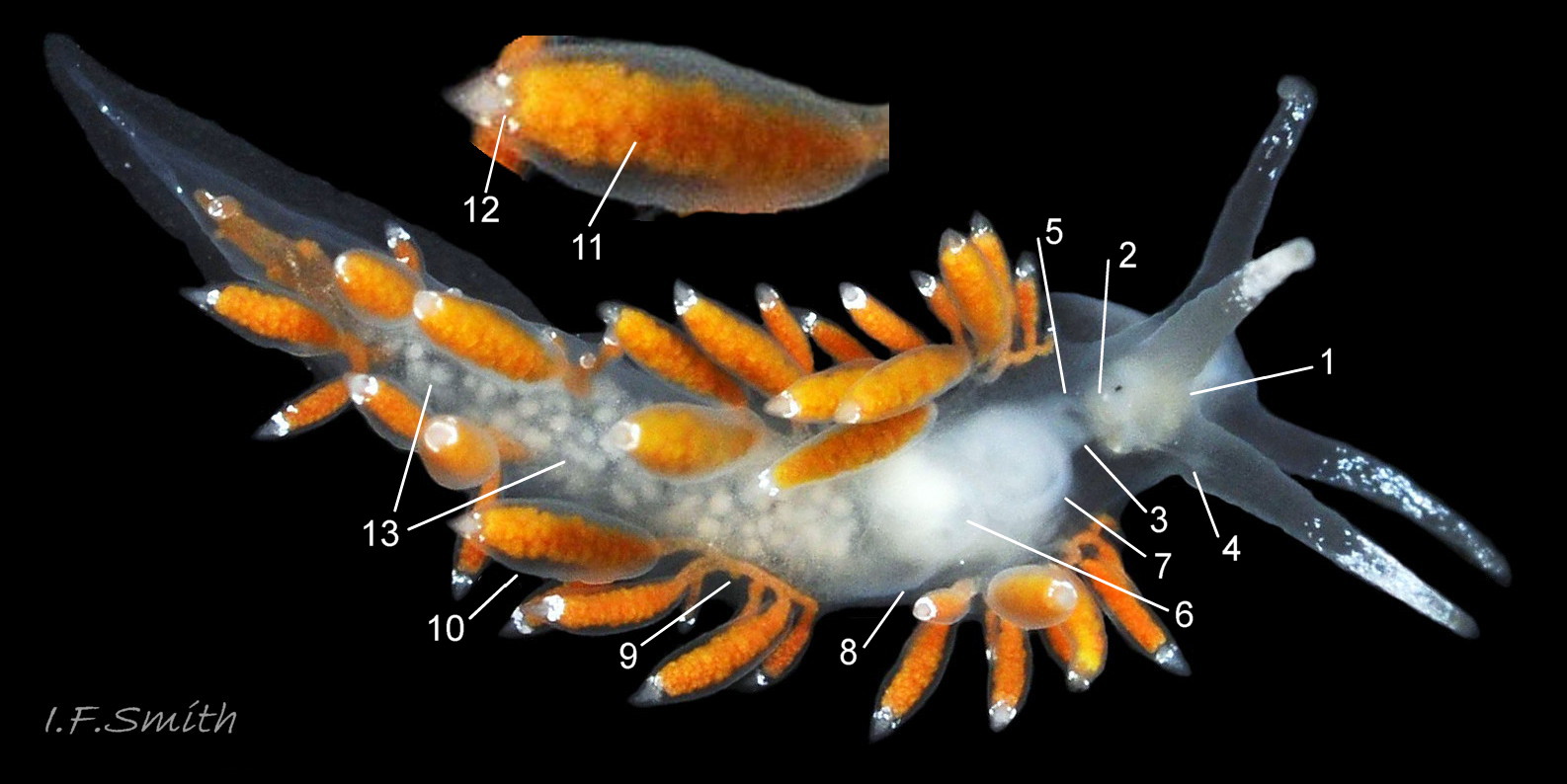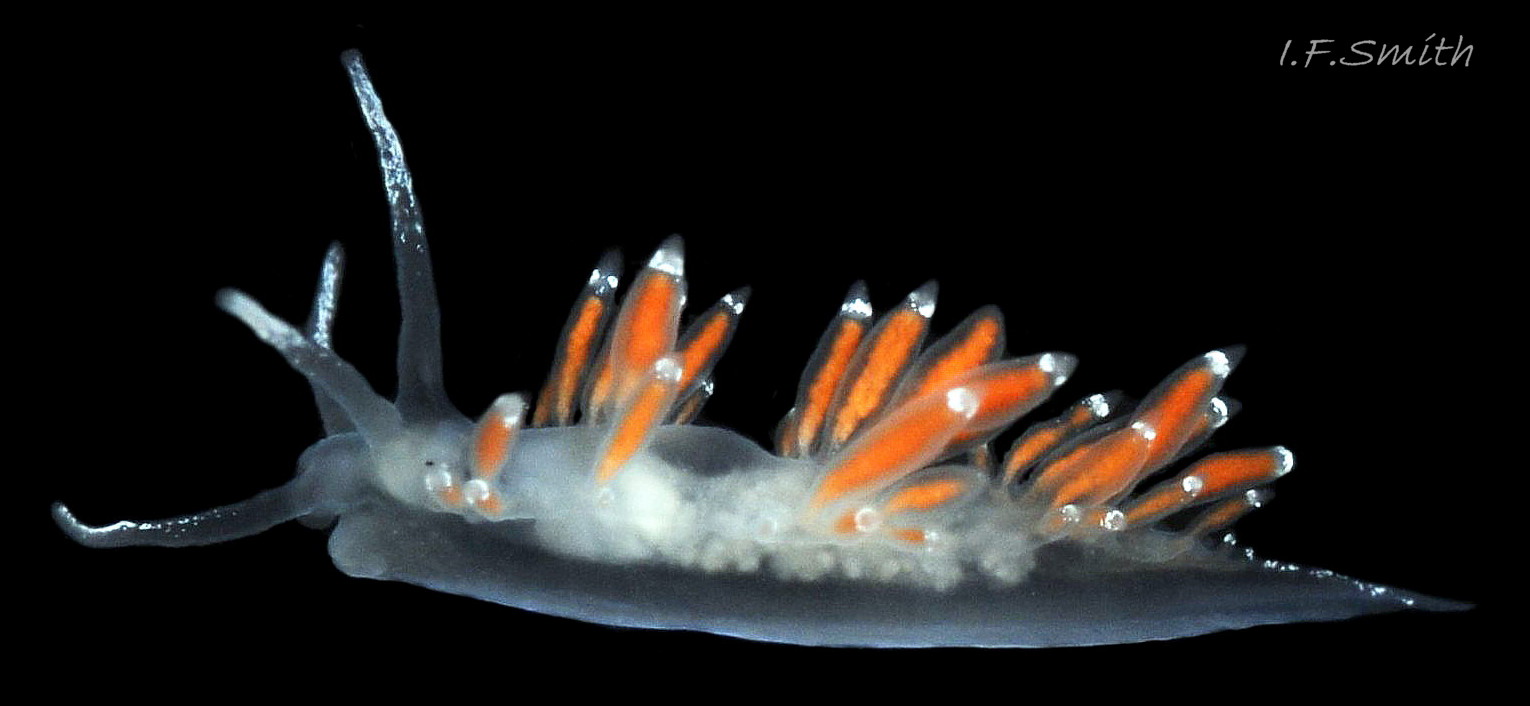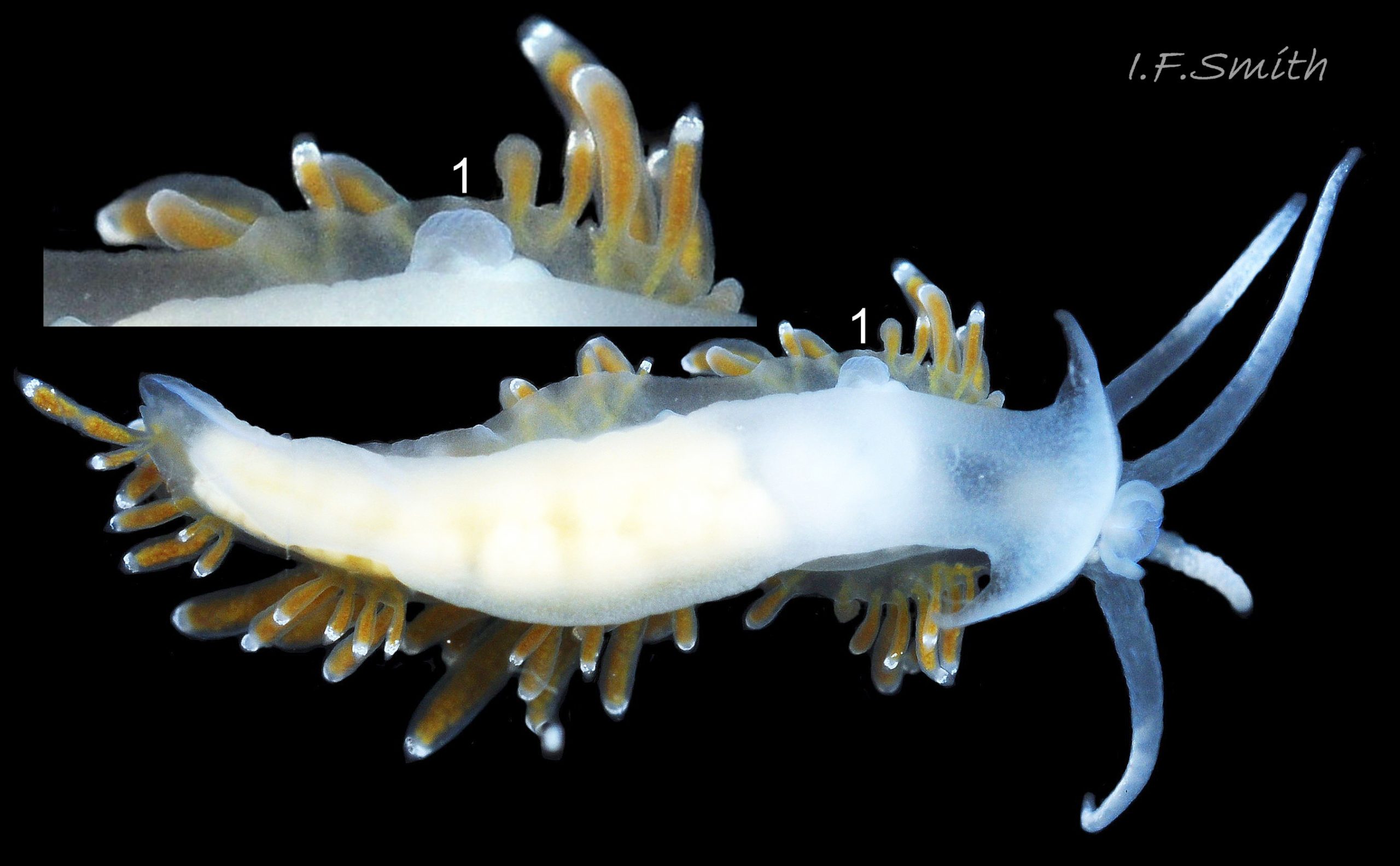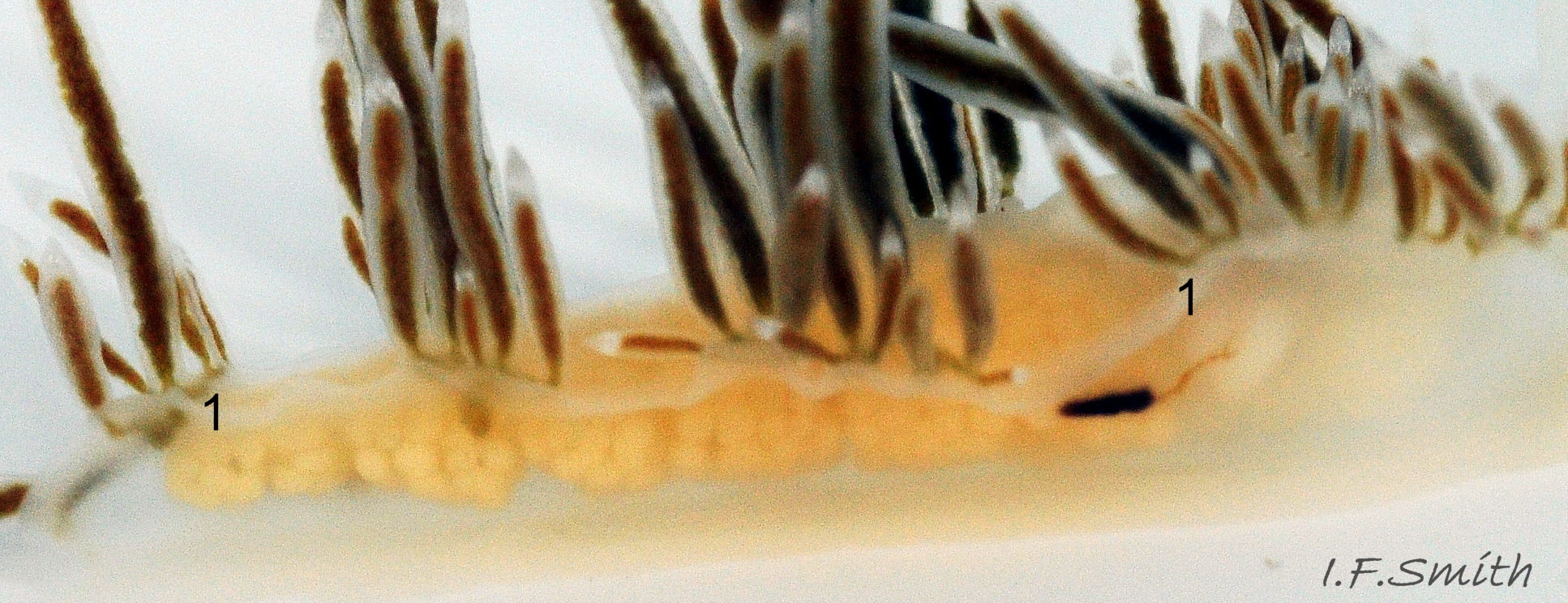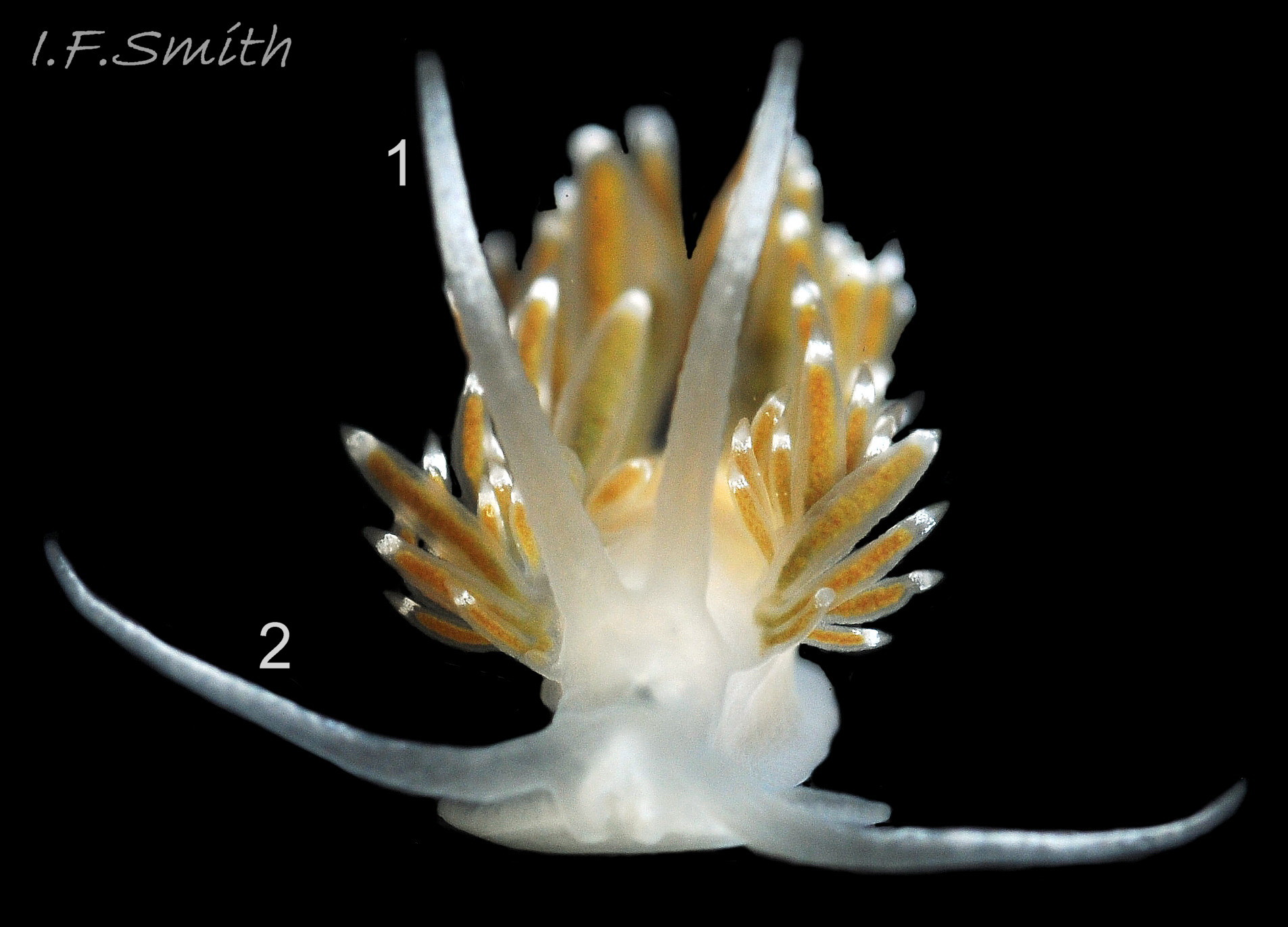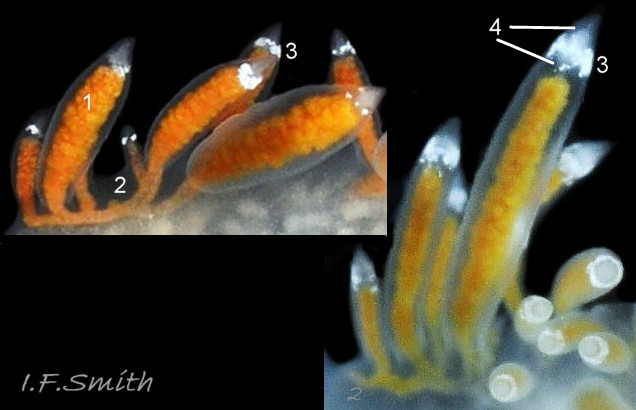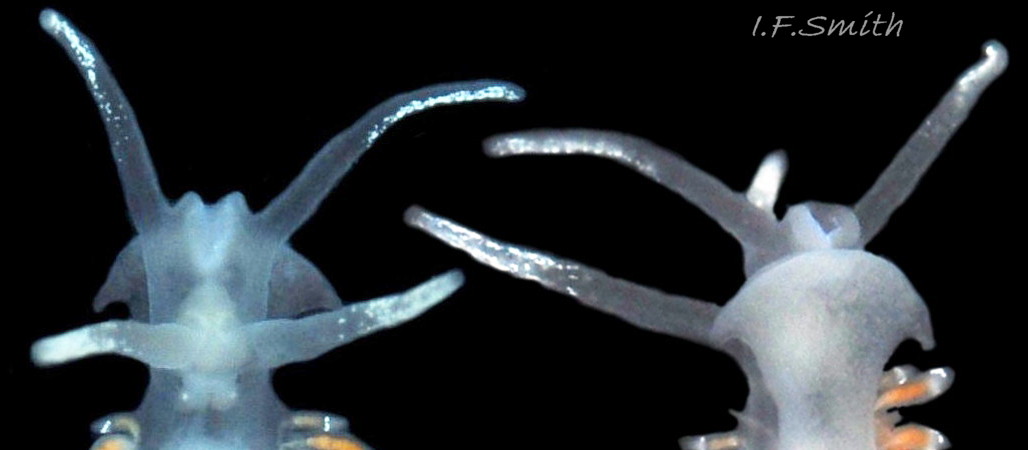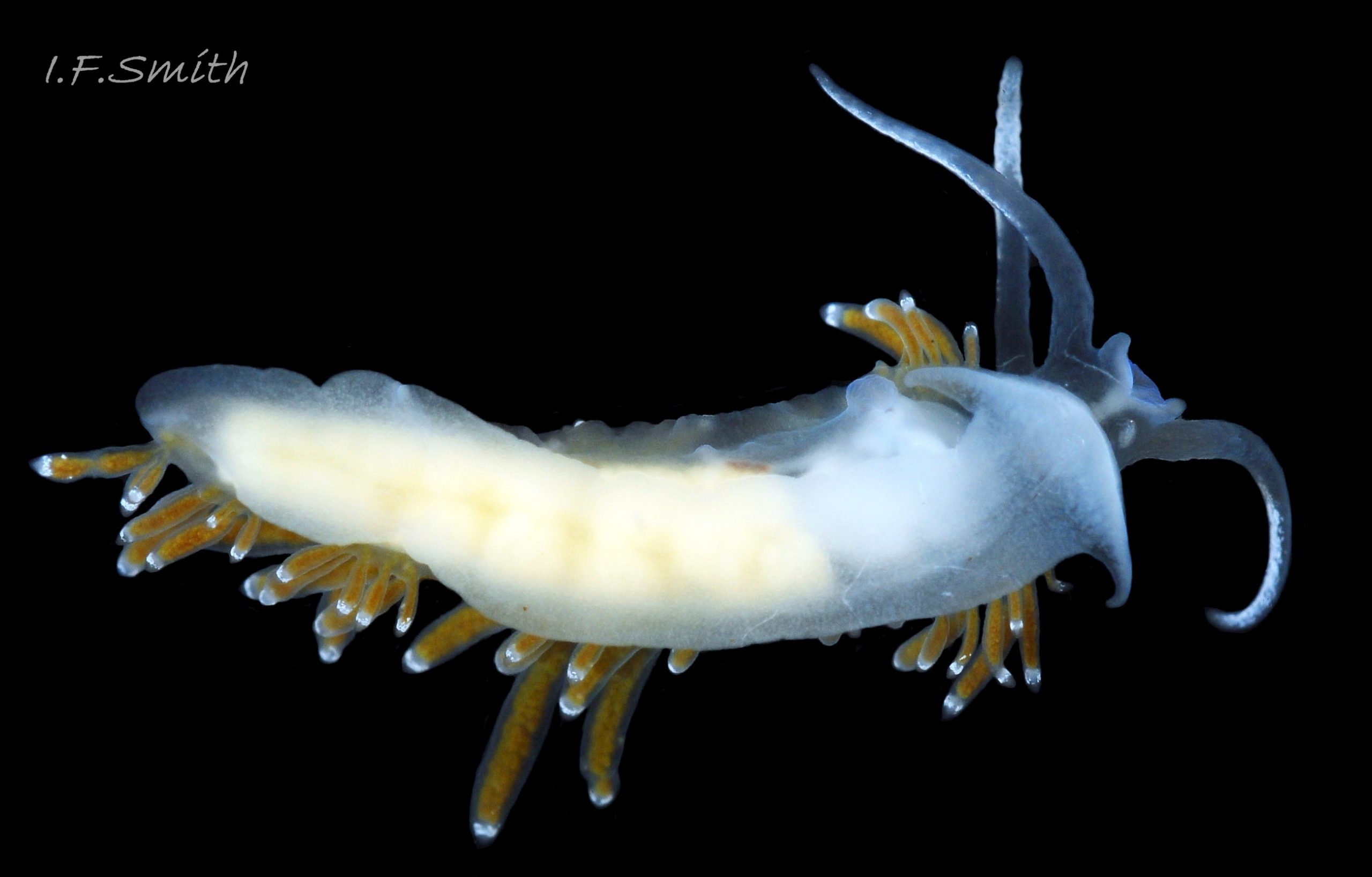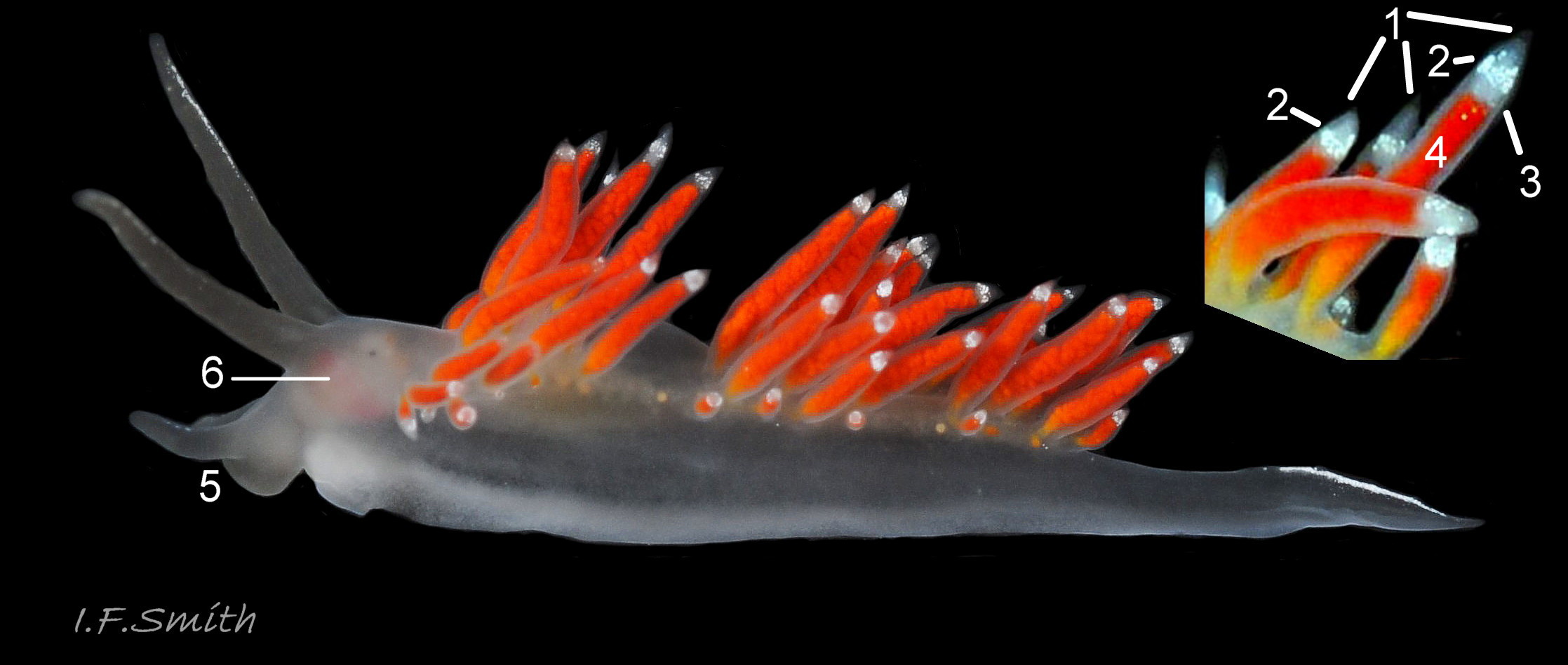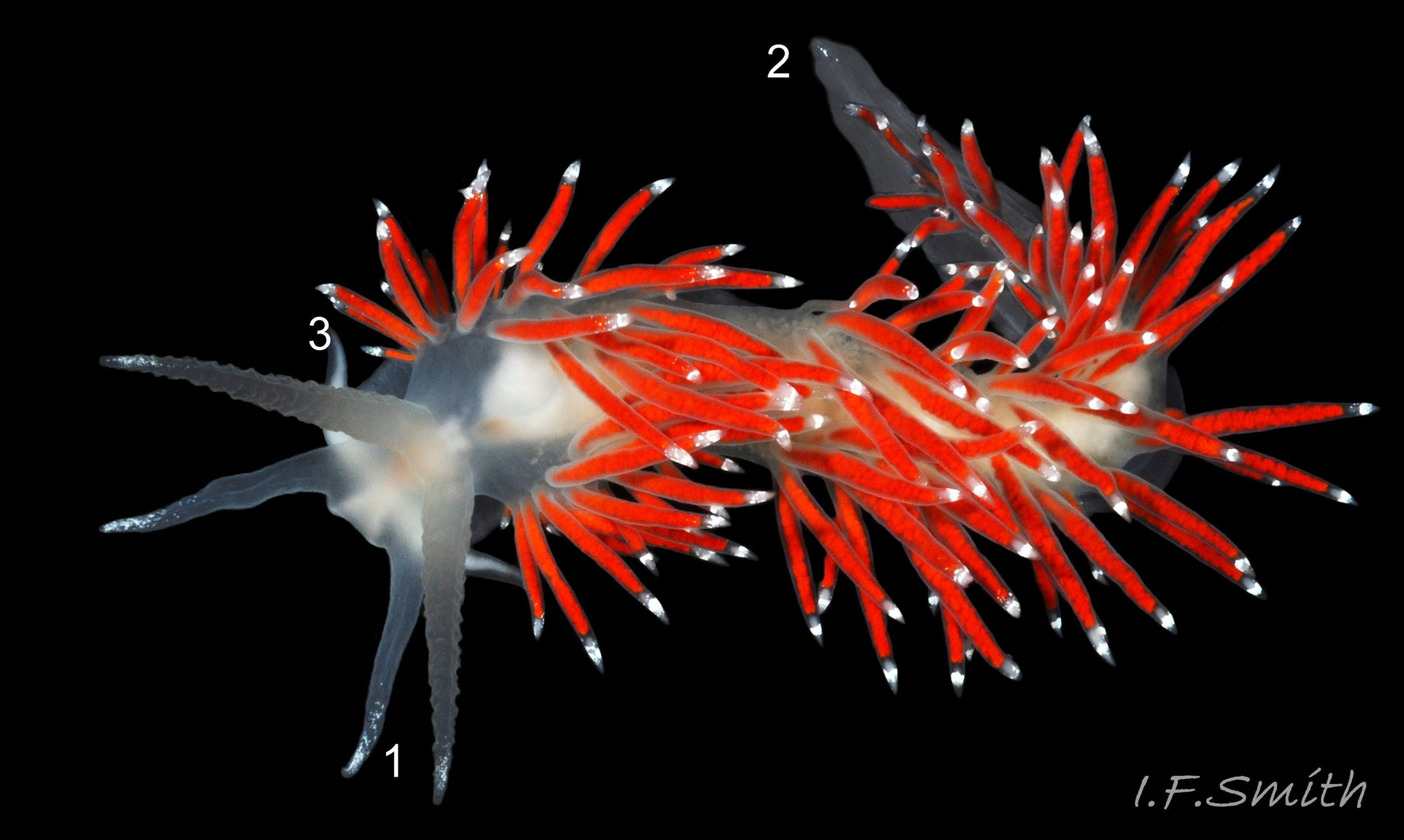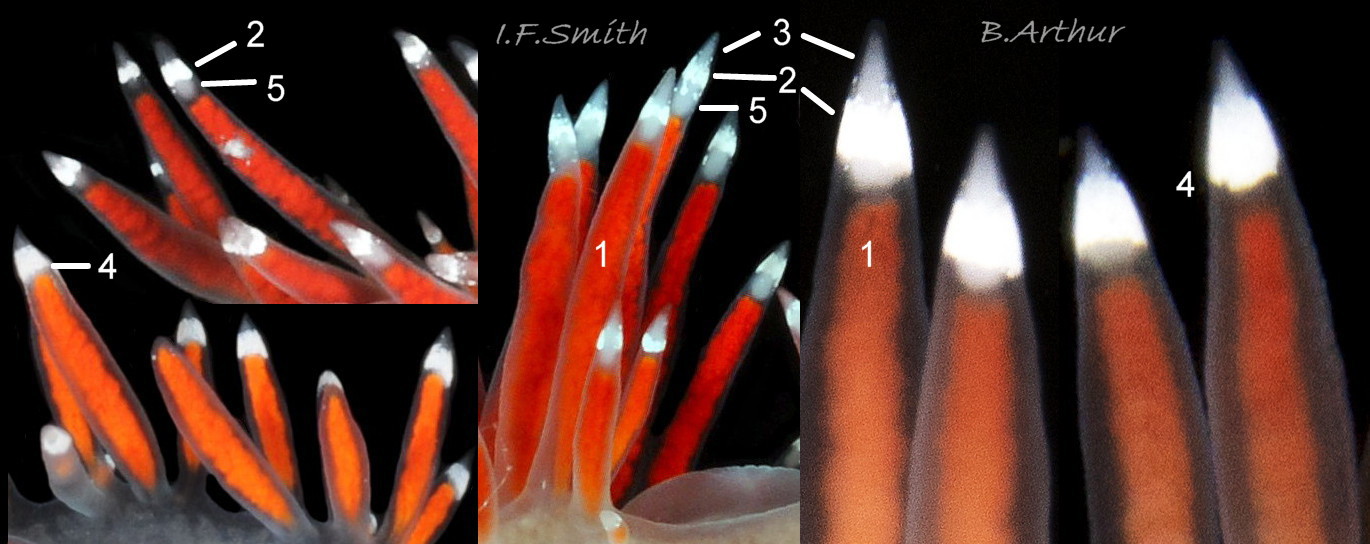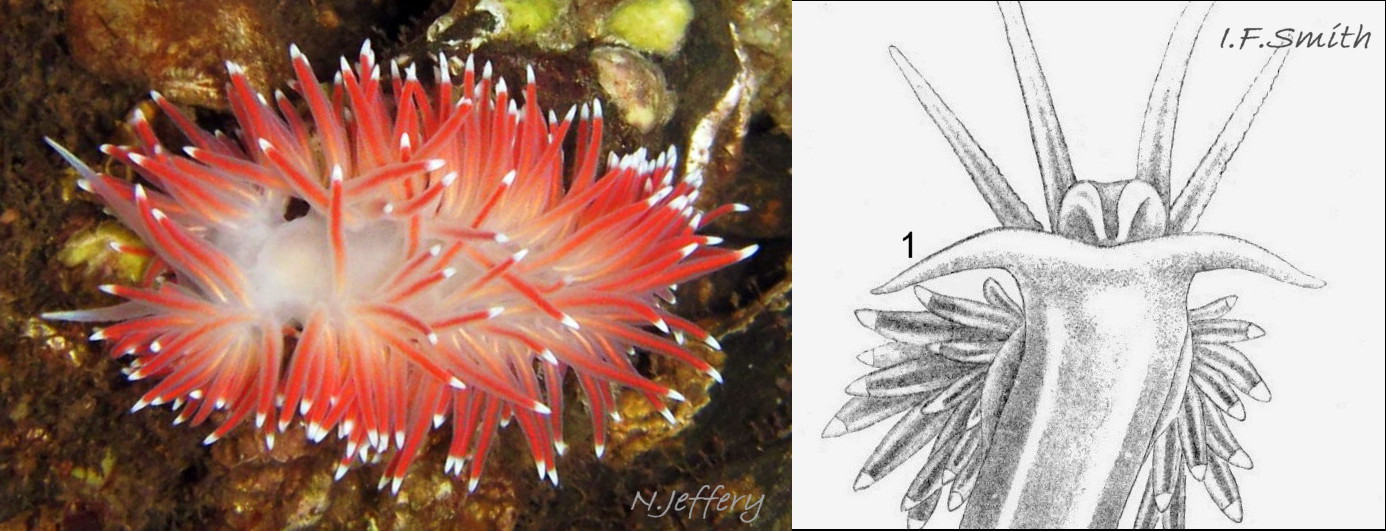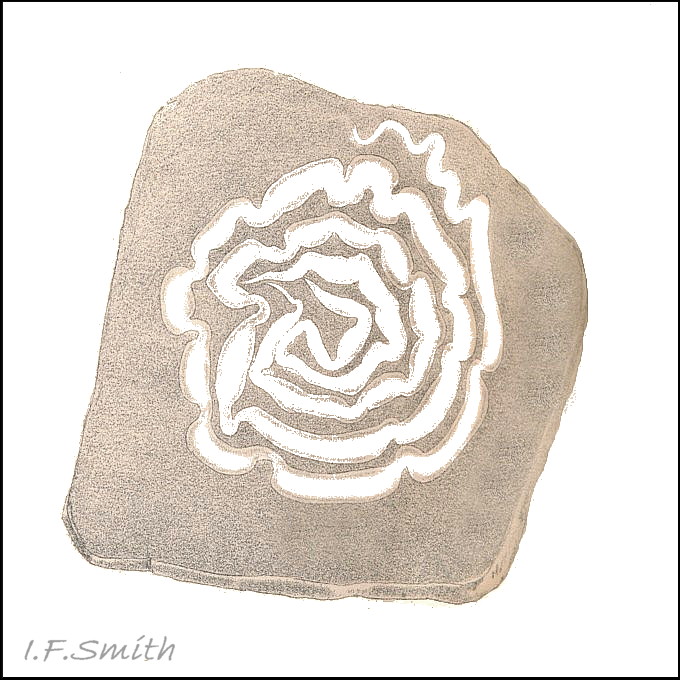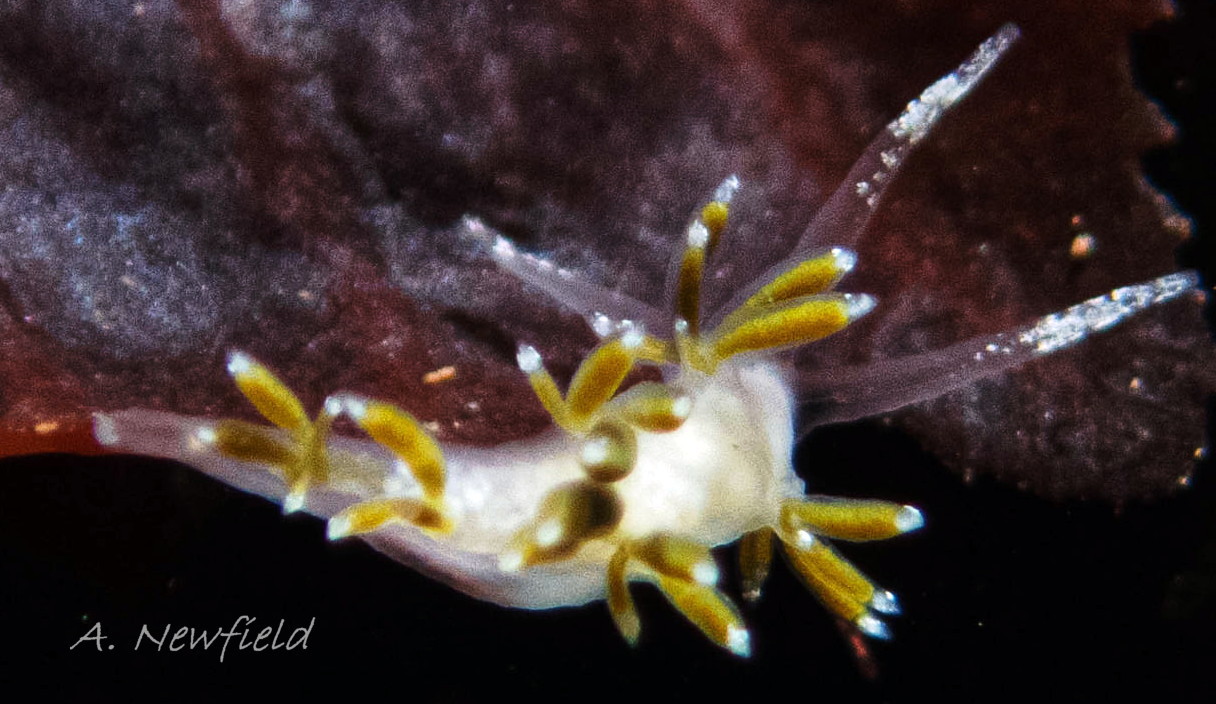Click image to enlarge with full caption. Main text below slider.
Coryphella gracilis (Alder & Hancock, 1844).
PDF available at
www.researchgate.net/publication/361462903_Coryphella_gra…
Current taxonomy: World Register of Marine Species www.marinespecies.org/aphia.php?p=taxdetails&id=139981
Synonyms: Eolis gracilis Alder & Hancock, 1844; Eolis smaragdina Alder & Hancock, 1851; Flabellina gracilis (Alder & Hancock, 1844); Microchlamylla gracilis (Alder & Hancock, 1844); Coryphella rufibranchialis var. clavigera Odhner, 1929; Coryphella verrucosa var. smaragdina (Alder and Hancock, 1851) [in Thompson and Brown (1976)].
GLOSSARY BELOW
Description
The small body, grows to a usual maximum length of 12 mm, occasionally 15 mm. It is very slender (Alder & Hancock, 1844-1854), more so than other European Coryphella spp. (Korshunova et al., 2017). Its width is about 10% of its extended length 01 Coryphella gracilis & 13 Coryphella gracilis . It is semi-transparent white, revealing the internal anatomy 03 Coryphella gracilis, including a distinctive coiled part of the reproductive system 01 Coryphella gracilis & 02 Coryphella gracilis . It matures when about 8 mm long, when the opaque white spheroids of the ovotestes are visible 03 Coryphella gracilis . On the tail there is a discontinuous, opaque white, medial line which is sometimes reduced to a few small spots 04 Coryphella gracilis . The hermaphrodite genital opening may protrude from the side below the cerata behind the right rhinophore 05 Coryphella gracilis .
The cerata are about as long as the body width 01 Coryphella gracilis but are fewer in number and relatively longer on early juveniles 06 Coryphella gracilis .They are often narrowed at the base and appear elliptical 03 Coryphella gracilis . They are fewer and flex less than the longer cerata of similar species, and leave much of the notum exposed. On each side of the body they are arranged in up to 5, occasionally 6, linear groups. Each group arises from a pronounced notal ridge, which is transparent, colourless so often difficult to discern 07 Coryphella gracilis . The bright red, orange-red, ginger-brown, yellow 06 Coryphella gracilis , olive-brown 08 Coryphella gracilis or green 09 Coryphella gracilis internal digestive gland is granular 03 Coryphella gracilis . The gland is visible in the transparent cerata and in the notal ridge connecting them 10 Coryphella gracilis . The digestive gland does not occupy the transparent, colourless apical c. 15% of each ceras which contains an oval white cnidosac and has a thin, irregular, opaque white subapical ring on the surface.
The translucent white rhinophores are smooth or slightly wrinkled with white surface pigment on the distal half 08 Coryphella gracilis . The head has translucent white oral tentacles with white surface pigment distally. They are a similar length to the rhinophores. The outer lips of the mouth are large and prominent 11 Coryphella gracilis & 12 Coryphella gracilis .
The anterior of the foot is usually rounded and variably extended laterally into short 11 Coryphella gracilis or long 12 Coryphella gracilis , triangular, propodial tentacles, giving the anterior a crescentic form. When fully extended the propodial tentacles are about as long as the width of the body 12 Coryphella gracilis . The translucent sole reveals spheroid, white ovotestes and other viscera 13 Coryphella gracilis ; but early juveniles lack ovotestes . When the ovotestes are fully developed they may obscure the view through the sole 14 Coryphella gracilis .
Key identification features
Coryphella gracilis (Alder and Hancock, 1844)
1) Cerata length about same as body width 01 Coryphella gracilis ; relatively longer on early juveniles 06 Coryphella gracilis . Narrowed at base so sometimes elliptical 03 Coryphella gracilis . Arise from a pronounced notal ridge 07 Coryphella gracilis containing the digestive gland under cerata.
2) Digestive gland in cerata is granular 03 Coryphella gracilis , colour varies red, brownish, orange, yellow or green. Narrow, often fragmentary, subterminal opaque white ring on cerata 10 Coryphella gracilis .
3) Opaque white dorsal line on tail is sometimes fragmentary 04 Coryphella gracilis or missing. No line on rest of body. Distinctive, internal, coiled structure 02 Coryphella gracilis behind rhinophores. White ovotestes are visible when 8 mm long, at which size ovotestes are missing in similar larger species.
4) Distinct triangular, propodial tentacles. When fully extended, length nearly as great as body width 12 Coryphella gracilis .
5) Scattered records around Britain and Ireland. Few or none in southern half of east coast England and north-east Irish Sea.
Similar species
Coryphella verrucosa rufibranchialis 15 Coryphella gracilis & 16 Coryphella gracilis.
1) Cerata as long as the width of the body, and held at varying angles, often across each other.
2) Cerata have a narrow, subterminal, opaque white ring.
3) Continuous white dorsal line on tail, sometimes a broken, white, dorsal line on body.
4) Propodial expansions sometimes form small propodial tentacles.
5) Recorded from Scandinavia, Britain, Bretagne and also Atlantic and Pacific coasts of North America, Bering Sea and Sea of Japan (Thompson and Brown 1984).
[Coryphella verrucosa verrucosa omitted from comparison as it is unlikely to be confused with C. gracilis]
Coryphella browni Picton, 1980. 17 Coryphella gracilis & 18 Coryphella gracilis
1) Cerata length up to twice the body width.
2) Broad white band on cerata distally, but no pigment on apex.
3) Interrupted white medial line, often reduced to a few dots or none, on tail. No line on rest of body.
4) Distinct tapering propodial tentacles, length about 25% of body width.
5) Scattered records around Britain and Ireland. Few or none in southern half of east coast England and north-east Irish Sea.
Carronella pellucida (Alder & Hancock, 1843). 19 Coryphella gracilis & 20 Coryphella gracilis
1) Cerata length greater than width of body.
2) White pigment covers entire distal end of cerata.
3) Opaque white dorsal line on tail. No line on rest of body.
4) Long tapering propodial tentacles as long as, or longer than, width of body.
5) Scandinavia and Scotland; the few English records on NBN are probably misidentifications.
Habits and ecology
C. gracilis lives sublittorally and at LWS on sheltered rocky shores with strong currents, on or near its hydroid prey; Eudendrium spp. 09 Coryphella gracilis , Halecium articulosum and Clytia johnstoni. Like other nudibranchs, it is a simultaneous hermaphrodite. Spawn is looped around its prey, or deposited as a spiral line on hard substrate 21 Coryphella gracilis , in mid April, May and possibly other months. Veliger larvae emerge and drift as plankton before transforming into the adults.
Distribution and status
C. gracilis is recorded from Iceland to the Atlantic coast of France, and there are records in north-east America 22 Coryphella gracilis , GBIF map www.gbif.org/species/2292262 . Scattered records around Britain and Ireland and sometimes locally common. Few or none in southern half of east coast England and north-east Irish Sea. It is probably under recorded because of its small size and confusion with other Coryphella spp. UK distribution map, species.nbnatlas.org/species/NHMSYS0021185584 .
Acknowledgements
For use of images I gratefully thank Jim Anderson, Billy Arthur, Roy Dahl, Nathan Jeffery, Amy Newfield, Tim Nicholson, Poul Rasmussen and Alastair Skene, and I thank Simon Taylor for specimens. For helpful advice I thank Jeff Goddard and Angel Valdes.
References and links
Alder, J. & Hancock, A. 1845-1855. A monograph of the British nudibranchiate mollusca. London, Ray Society.
Family 3, plate 17. www.biodiversitylibrary.org/item/131598#page/350/mode/1up
Family 3, plate 18. www.biodiversitylibrary.org/item/131598#page/354/mode/1up
Korshunova, T., Martynov, A., Bakken, T., Evertsen, J., Fletcher, K., Mudianta, W.I., Saito, H., Lundin, K., Schrödl, M. and Picton B. 2017. Polyphyly of the traditional family Flabellinidae affects a major group of Nudibranchia: aeolidacean taxonomic reassessment with descriptions of several new families, genera, and species (Mollusca, Gastropoda). ZooKeys 717: 1–139. doi.org/10.3897/zookeys.717.21885
Thompson, T.E. & Brown, G.H. 1976. British opisthobranch molluscs. London, Academic Press.
Thompson, T.E. & Brown, G.H. 1984. Biology of opisthobranch molluscs 2. London, Ray Society.
Glossary
buccal mass = anterior of digestive system including an odontophore which supports the anterior of the radula, and a complex of muscles to operate them and other mouthparts.
cerata = (sing. ceras) lobes on dorsum of aeolids and some other seaslugs.
circum-oesophageal nerve ring = ganglia-bearing nerve cord which encircles the oesophagus.
cnidocytes = explosive stinging cells of Cnidaria. en.wikipedia.org/wiki/Cnidocyte
cnidosac = storage capsule at tips of cerata of Aeolidiidae for ingested unexploded cnidocytes.
digestive gland = large organ in gastropods which acts like the liver and pancreas in mammals to absorb food.
distal = away from centre of body or from point of attachment.
ganglia = (sing. ganglion) knots on a nerve cord containing sensory cell bodies that conduct impulses to (innervate) organs of the body.
LWS = low water spring tide; two periods of a few days each month when tide falls lowest.
notal = (adj.) of the back.
notal ridge = ridge on dorsal surface.
notum = (of seaslugs) the dorsal surface.
ovotestis = (pl. ovotestes) hermaphrodite organ serving as both ovary and testis.
propodial tentacles = tentacular, lateral extensions on anterior of the foot.
propodium = anterior portion of gastropod foot. (adj. propodial).
rhinophores = chemo-receptor tentacles on top of head of nudibranch.
veliger = shelled larva of marine gastropod or bivalve mollusc which moves by action of cilia on a velum (bilobed flap). Stage may be passed in plankton or within liquid-filled egg-capsule.
